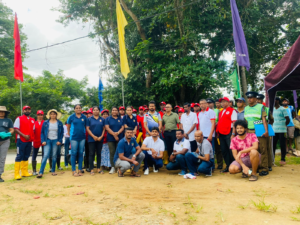Physical Address
23,24,25 & 26, 2nd Floor, Software Technology Park India, Opp: Garware Stadium,MIDC, Chikalthana, Aurangabad, Maharashtra – 431001 India
Physical Address
23,24,25 & 26, 2nd Floor, Software Technology Park India, Opp: Garware Stadium,MIDC, Chikalthana, Aurangabad, Maharashtra – 431001 India

The CFC team first collaborated with the Clean River Project and the Kandy Municipality Council (KMC) to organise an awareness program and river clean session for the students of Hillwood College Kandy. The location was near the Polgolla Dam, which is located in the Kandy district. Due to the positive feedback, we received from the community members regarding the program, they requested another program to be conducted in the same locality.

The second Clean up was held on the 16th of July 2023, at 9 am at the Polgolla Dam premises. The Commissioner of the Kandy Municipal Council, Mr Ishan Wijeythilaake, also participated in the event. He addressed the gathering and highlighted the importance of keeping the Kandy environment clean and influencing positive behaviours among the general public. Among the volunteers were 50 youth members from the Red Cross Kandy, community members and staff from the KMC.
The volunteers were divided into four groups and taken to designated cleaning areas along the river bank. A barge was also set out at the top of the Dam to collect the waste accumulated at the barrier on the river’s stream. The waste collected mainly was single-use PET bottles, polythene bags, glass bottles and rubber slippers. It was also alarming to see bags full of diapers and sanitary napkins dumped along the river bank. The Garbage was segregated into bags separately and loaded into the KMC lorry, which will transport them to the waste management centre in Gohagoda, Kandy. The Clean up was concluded after three long hours of hard work by all the volunteers. Yet the groups could only clear a fraction of the waste along the Polgolla river banks.

It was evident that awareness among the Sri Lankan public still needed to be improved regarding waste management, yet keeping the city and our rivers clean is essential. As suggested by Mr Wijethilake, we need to start these behavioural changes at home and then expand them by influencing our neighbourhoods and the whole district.
Why we should keep our rivers clean.
Mahaweli River is the longest river in Sri Lanka, at 335 km and one of the country’s most polluted rivers. Contrary to the common misconception that the Mahaweli River starts at the Sri Pada mountain, it gets its water from Horton Plains, Kirigalpoththa and Thotupola mountain range. From the inception point at Polwathura, it reaches the ocean in Trincomalee on the east coast.
With the start of the Mahaweli Development programme, the Mahaweli River and its tributaries were dammed at several locations to allow irrigation in the dry zone, Production of hydroelectricity from six dams of the Mahaweli system supplies more than 40% of Sri Lanka’s electricity needs. The Dams are Kotmale, Polgolla, Victoria, Randenigala, Rantembe, and Bowatenna.
In addition to providing water for irrigation and hydropower generation, rivers are the primary source of fresh water pumped into water lines after being treated. When the waters are highly polluted, it consumes more time, energy and money to purify it for human consumption. Rivers are also home to some of Earth’s most diverse and endangered wildlife. Rivers are a vital and vibrant ecosystem for many birds, fish, reptiles, crustaceans, and more species. These rivers are essential for people’s livelihoods; many locals depend on these rivers from fishing to sand mining. Rivers are considered the veins of our planet, transporting water and nutrients needed for the survival of our ecosystems. Among the nutrients transported is carbon withered from underwater minerals; these rivers hold considerable carbon dioxide. This phenomenon is named carbon transfer which captures atmospheric carbon and flows it to the ocean.

Hence, there is more than one reason why we should keep our rivers clean and healthy. We must ensure that these natural ecosystems remain to provide services for many generations.